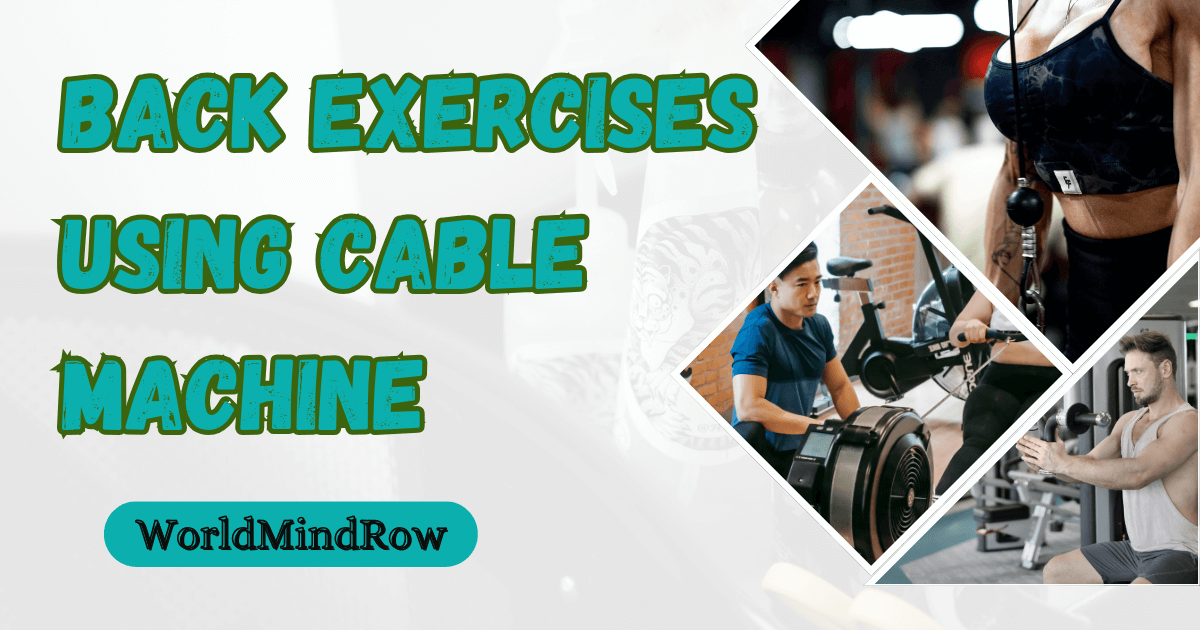Working for an ideal back with valuable and multipurpose workouts. An overview of the best back exercises using a cable machine for each muscle group. Discover the best back exercises using cable for anyone from beginners to advanced, and crush your goals!
Introduction:
What Are Cable Exercises?
Cable exercises use a cable machine with adjustable weights and pulleys. Such back exercises using cable machines constantly provoke the tone of muscles. That is why they perfectly activate them. Cable machines can do many exercises. They come in dual cable columns and crossover stations.
Why Focus on Back Exercises Using Cable?
Cable work is undoubtedly needed for a more muscular back and an overall in-shape body. They improve posture, decrease the risk of injury, and develop a solid functional back. With the help of cable exercises, you can align and strengthen all muscle fibers to yield a balanced back that has been defined with exact force over range.
Benefits of Back Exercises Using Cable:
Back exercises using cable machines are among the best. They isolate and build your back. They let you isolate muscles, keep tension, and do many back exercises. These are key in any back workout.
Isolation and Targeting:
Cable machines isolate parts of your back by adjusting the height and grip. This accuracy targets the lats, rhomboids, and traps. So you can enjoy a more evenly developed back.
Constant Tension:
The cables provide constant tension. It keeps our muscles engaged longer, causing more growth. This steady resistance helps lifters control weights and stay in good form.
Versatility:
The great thing about a cable machine is that you can do hundreds of exercises on it and an endless amount of attachments. You can adjust the exercises according to your goals or what you want/can do physically.
Controlled Movement:
They create a controlled path of motion during exercises. This ensures the user performs them safely and with maximum muscle engagement. It lowers the risk of injury in training and boosts gains.
Top Cable Back Exercises:
This is where some of the top back exercises using cable come in and why you need to do them. We have the best cable machine exercises for both your upper and lower back. They will build a strong foundation for more muscular shoulders.

Cable Exercises for the Upper Back:
Lat Pulldown:
The Lat Pulldown is essential for developing a more comprehensive back. This exercise works the least. It helps create a V-shaped torso.
Muscle Focus: Lats, upper back.
Variations: Wide grip, close grip.
Common Mistakes: Using too much weight, improper form.
How to Perform:
- Begin by sitting at the rowing machine, setting your knees in place.
- Grab the bar firmly and bring the shirt to the chest
- Squeeze the one’s shoulder blades together and preserve your return in a neutral role.
- Return to the beginning placement gradually.
Seated Cable Row:
This exercise works the middle back. It adds thickness and improves posture.
Muscle Focus: Middle back, rhomboids.
Variations: Single-arm row, different grips.
Common Mistakes: Using momentum, poor posture.
How to Perform:
- Sit with your feet braced and grasp the handle.
- Bring the handle back towards you, only moving your shoulder blades.
- Arms should be fully extended, and the back should remain straight.
- Return slowly to the starting position.
Face Pulls:
Face pulls improve posture and shoulder fitness by focusing at the top back and rear deltoids.
Muscle Focus: Rear deltoids, upper back.
Variations: Adjust cable height.
Common Mistakes: Using too heavy weight.
How to Perform:
- Set the cable at chest height and grasp the ropes.
- Pull the ropes towards your face, keeping elbows high.
- Return slowly to the starting position.
Cable Pullovers:
Cable Pullovers focus on the lats and chest, contributing to a broader upper body.
Muscle Focus: Lats, chest.
Variations: Overhead vs. straight-arm pullover.
Common Mistakes: Incorrect arm position.
How to Perform:
- Attach a bar to the high pulley and grasp it.
- Stand with feet shoulder-width apart and extend your arms up.
- Pull the bar down and over your head, engaging your lats.
- Return to the starting position.
Cable Exercises for Lower Back:
Cable Deadlift:
This exercise targets the lower back and hamstrings. It is a controlled alternative to traditional deadlifts.
Muscle Focus: Lower back, hamstrings.
Variations: Conventional vs. sumo stance.
Common Mistakes: Rounding the back, improper weight.
How to Perform:
- Stand with feet hip-width apart and grasp the handle.
- Hinge at your hips, lowering the handle while keeping your back straight.
- Engage your lower back and return to the starting position.
Single-Arm Cable Row:
This unilateral exercise helps fix muscle imbalances. It develops the lats and rhomboids.
Muscle Focus: Lats, rhomboids.
Variations: High vs. low pulley.
Common Mistakes: Twisting torso, uneven rowing.
How to Perform:
- Put one foot forward and hold the handle with just one hand.
- Keep your back straight, and pull the handle towards you like doing a reverse bench press.
- Fully extend your hand and return to the starting position.
Standing Cable Hyperextensions:
This exercise, ideal for strengthening the lower back, tests its endurance.
Muscle Focus: Lower back.
Variations: Adjust weight and stance.
Common Mistakes: Overextending, poor posture.
How to Perform:
- Stand facing the cable machine with the cable set low.
- Use a hyperextension bench if available, or brace yourself.
- Bend at the waist, retaining your back immediately.
- Return to the upright role.
Tips for Effective Back Workouts:
Use these tips to maximize and enhance your back exercises using the cable machine experience. They will help you get the best results and keep proper form.
Focus on Form: Use the correct form to target muscles and avoid injury.
Control Your Movements: Perform exercises slowly to engage your muscles.
Engage Your Core: Tighten your core. It will stabilize your back and improve your balance.
Use a Full Range of Motion: Move through the full range of each exercise. This ensures a complete muscle stretch and contraction.
Add Variety: Mix cable exercises to target all back muscles and prevent plateaus.
These tips will improve your back exercises using cable machine experience. They’ll also reduce your injury risk.
Building a Balanced Routine:
The cable machine is excellent for building a complete back. So, you should create a workout that trains every part of your back. For more on overgrooming and your schedule, here’s how:
Integrate Cable Exercises: Do back exercises using the cable, like lat pulldowns, in shorter full-body workouts.
Plan Your Workout Split: Alternate upper-body, lower-body, and rest days. This helps recovery and builds muscle.
Adjust Intensity: Vary weights, sets, and reps to avoid plateaus and ensure progress.
Integrate Cable Exercises: Combine cable back exercises with other muscle groups. For example, pair lat pulldowns with lower-body workouts.
Plan Your Workout Split: Alternate upper body, lower body, and rest days. This allows for recovery and muscle growth.
Adjust Intensity: Vary weights, sets, and reps to avoid plateaus. This will keep your progress going.
Sample Routine for Different Fitness Levels:
Beginner: Do basic back exercises using cable, like lat pulldowns and seated cable rows. Use moderate weights and reps.
Intermediate: Mix cable rows and face pulls. Use different grips and angles for variety.
Advanced: Add complex moves, like single-arm cable rows and cable pullovers. Use techniques like pauses and resistance bands for more intensity.
These routines include back exercises using cable machines adapted to different fitness levels.
Common Mistakes and How to Avoid Them:
Incorrect Form:
Maintain proper form to prevent injuries and ensure effective workouts. Don’t arch your back or move erratically.
Incomplete Range of Motion:
Do each exercise through the full range of motion. This will maximize muscle engagement.
Overtraining:
Watch for signs of fatigue and soreness. Add rest days and get enough sleep to recover.
Equipment Misuse:
Set the cable machine and choose weights for good form. Avoid excessive weights that compromise your technique.
Final Thoughts:
Doing back exercises using a cable machine will help up your back gains and definition. Avoid mistakes, learn which exercises to do and at what intensity, and use a balanced workout program with cable training for the best results possible. Always remember that good form makes all the difference and matters more than anything else when working out results.
Cable machines can be adjusted to fit any skill level. So, whether you are new or fit, these back exercises using a cable machine will keep your progress at peak performance. Add these exercises to your back routine for lasting gains.
FAQS:
How do you train back using cables?
Train your back using cables with exercises like lat pulldowns and cable rows. These back exercises using cable will work and strengthen your back.
How to train lats with cables?
Train your lats with cables. Do cable lat pulldowns and single-arm cable rows. These back exercises using cable machines focus on engaging your lats.
Are cable rows a good back exercise?
Yes, cable rows are a great back exercise. They effectively target the back muscles. They are essential in a solid routine of back exercises using cable machines.
Meta Description:
Use a cable machine to build a more muscular back with our top back exercises. Discover effective moves to enhance strength and posture. Start your workout today!
Know more about Dumbbell Shoulder Exercises

1 thought on “Back Exercises Using Cable Machine for a Stronger Back”